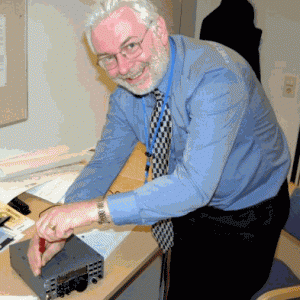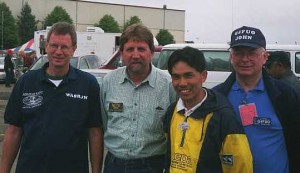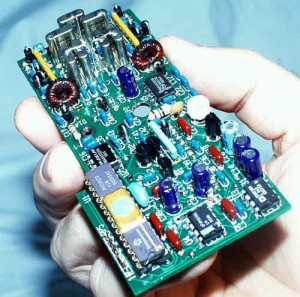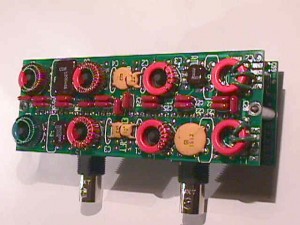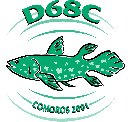A Rig for All Seasons – The Elecraft K2
When Steve G3VMW asked me to write about my experiences with the Elecraft K2 I was delighted. I need to say from the start of this article that I am biased “The Elecraft K2 is the most fun radio I have ever owned and what is more I built it myself!”.
Just a bit of history about me, I’ve been interested in radio since I was 12 and got my first callsign in 1973. My interest turned into a job and over the years I’ve built one or two electronic and radio based projects but none so good as the K2. In fact if I could only keep one radio in my shack I would chose to keep the K2. If you want to find out more read on, but beware, you may end up a K2 owner.
My Route to the K2
I first became aware of the K2 when I saw an advertisement in a QST. It only contained brief details of a radio you could build that covered all the HF bands and was small fully featured and portable. No price details were given but I was hooked!
Over the past couple of years my work has taken me to The Netherlands, Spain, France, Belgium, Norway, America and Finland. I’ve also been on holiday to one or two other places. Whether I’m working away or just on holiday I always try and encompass some radio. Initially this was VHF and UHF, no DX but radio nonetheless. From time to time I managed to work HF from a foreign Ham’s station. I found HF operation more satisfying and eventually when I was in Europe with my car I used to take along my TS570D and a full sized doublet. I spent many hours in the car operating but when it was cold or wet operating periods were curtailed.
Besides operating portable in mainland Europe I was often out portable in the UK. On one of these occasions I had a QSO with an old friend from Grantham Andrew G4HVC. It was just before my excursion to Dayton 2000. During the QSO I discovered that Andrew was building a K2 and that was the clincher I decided there and then that I would buy a K2 at Dayton!
Dayton 2000
This is hard for me to write. It would be all to easy to tell you all about Dayton. The 2000 plus table top flea market, the friends from around the world, the DX banquet, the preview of the new Kenwood radio…….I’ll quit now.
On arrival at the K2 stand, talk about small world! Stood next to me was Bob G3ZEM buying his second K2. Bob used to live within 25 miles of my QTH and although I new of him I’d never met him before.
I filled in the order form paid by credit card and carried away my K2.
K2 options
The K2 is a modular radio and can be purchased as a basic CW only transceiver or with a number of additions giving more functionality.
The optional kits are:
- SSB Adapter
- Noise Blanker
- Automatic ATU
- 160 Metre
- Internal Battery
I’d planned to purchase everything, however, the battery kit was not available at Dayton because the Elecraft team had flown in from California and the Battery Kit’s are heavy and expensive to ship by air.
Homeward bound
I carried my K2 kit in my hand luggage from Dayton to Phoenix. I had left my XYL in Arizona at Tom NE7X’s QTH. I stayed with Tom for another week working the radio and visiting local attractions. I operated CW mobile for the first time ever! I brought my K2 back to the UK in my hand luggage. If my luggage was lost I could replace it or do without. How could I replace the K2 if it was lost?
Home, Work and constructing the K2
Once I was home and back at work I had a problem! How was I going to find time to build the K2. I took the kit with me to the local radio club, everyone commented on the quality of the kit. Everything is packaged to ease construction, for example the resistors are supplied on bandoleers sorted into the order of insertion into the PCB. In this kit there is no point to point wiring to complete the three PCBs just plug together. If I could free some time construction would be easy. In June I went on holiday without lifting the soldering iron I borrowed Steve’s IC706 and operated CT/G4FUO from the Algarve.
I needed to free some time or my kit would always be in kit form.
Go for it
At the start of July I decided to build the basic radio. Construction is not for the absolute beginner. If you can make a good soldered connection, identify components, understand that leads should be a as short as possible and have reasonably good eyesight then this kit is for you. My eyesight is not perfect I use a bench magnifier and a watchmakers eyeglass as aids.
The kit is assembled and tested in stages. Each of my stages worked perfectly first time (almost). The kit uses a number devices that can be damaged by ESD and I used an ESD wristband connected to earth as protection during construction and test. Beware, static sensitive devices can be damaged totally or may fail prematurely if no precautions are used.
The three boards that make up the kit are the front panel (controls and display), the control board (PIC controller and frequency counter) and the RF board (everything else).
As you build tests are carried out at a number of stages along the way, the notable ones being the front panel functionality, keyer, single band receive, single band transmit.
Staged construction and test is very reassuring and if you encounter a problem you can sort it out before moving on.
I completed a CW only version of the kit in just over forty hours of construction by mid July 2000.
What then?
In July I found myself facing another business trip to America. At about the same time I’d been Emailing Elecraft in an attempt to discover how much it would cost to purchase a battery kit and get it shipped to the UK. Because of the weight of the battery shipping to the UK was almost the same cost of the K2 battery kit.
I must say that Elecraft Sales is one of the most efficient organisations I have ever dealt with. When you Email them you always get a response and many times within the same working day. I ordered another K2 and a battery kit on the Friday and received them at my hotel on the Monday delivery was by FedEx. Well done Elecraft!
I installed the battery kit in August 2000, the Auto ATU in January 2001 and the SSB and 160 metres in March 2001. I only have the noise blanker left to construct.
Problems encountered
Besides my own K2 I’ve worked on two others and none of them are failed projects. After all when you’ve spent the thick end of £600 on the kit you need to complete otherwise its a waste of money. Elecraft state in the construction manual that you must check for components incorrectly inserted, dry joints and solder splashes. On my K2 I admit to a solder splash shorting out the audio at the headphone jack and a pin on the auto ATU PIC that was not soldered. On the other K2’s I looked at I removed two solder splashes and soldered two other missed joints. The moral is clear: Inspect the boards carefully before powering up.
Andrew G4HVC also had an open circuit loudspeaker an Email to Elecraft was all that was required for them to ship a replacement.
Elecraft kits are good quality and the customer service is second to none.
Outstanding Performance
I forgot to mention one important fact. The K2 receiver specification is comparable to some of the most expensive rigs in the market place. If you check out the Elecraft web site www.elecraft.com you will find comparisons to top of the market rigs such as the FT1000 and the IC756.
My K2 is amazing, on CW the full break in is so pleasant to use. The receiver has a ladder filter with bandwidths down to 100Hz selected at the push of a button. The auto ATU will tune random wires, coax antennas and balanced feeders (requires external balun).
Field Operation Test
Once I’d incorporated the ATU in my K2 I decided I’d try the rig outdoors. I packed a bag with the rig a reel of wire and a small paddle for CW. I live just outside York and I thought it would be fun to set up at a location within the City. My first stop was the Museum gardens and I used two ornamental lamp posts as make shift masts for the longwire. This was a mistake! I was moved on by council employees, very embarrassing! To make matters worse the strap on the bag containing the K2 broke and the rig crashed down to the ground. A none preferred drop test! I moved to a secluded location on the City walls and set up the antenna. Disaster! The rig functioned but the Auto ATU reported that it was not installed. Obviously as a result of the drop test! I did work a GW station on 80 metres and Alex G0WUY who lives in York. I went QRT and took the rig round to Alex’s QTH. We opened it up and Alex discovered the problem, I had not soldered pin one of the ATU PIC. All the holes on the K2 are plated through and when I had tested the ATU the pin must have been touching the side of the hole. Dropping the K2 had caused the pin to become disconnected. Once soldered the ATU performed perfectly, Alex ran some fifteen feet of wire up the stairs of his terraced house and we worked into DL, HB and a couple of G stations.
OH/G4FUO
I started in January 2001 working on a project in Finland. Initially I’d been taking my VHF/UHF handheld but results were disappointing because the local repeater had been off the air. I constructed the auto ATU so that I could take the K2 to Finland and not have to worry about having a resonant antenna. Operating from hotels is hard enough but trying to erect resonant antennas often renders operation impossible.
My apartment hotel in Finland is radio friendly and I got a room and soon had a long wire erected. During my first stay I made a number of QSOs with stations from all around Europe. I worked Steve G3VMW and Alex G0WUY. On my QSO with Steve I reduced the power to 100 mW and was still getting 559.
D68C
I arrived in Finland with the K2 for a second time with a plan to work D68C. When I arrived the room I’d been allocated was really poor for the erection of antennas. I spoke to Johanna the manager and she promised to change my room on the Friday so that I could take advantage of the weekend to work D68C. Johanna was true to her word and when I got back from work she gave me a key to a room on the fourth floor of the hotel. A quick look outside revealed that this was a perfect location. I planned to support one end of the long wire on a tree some two hundred and fifty feet from my room. Working outside in Finland in February is none preferred the temperatures have been around minus twenty Centigrade and any wind chill makes it feel up to fifteen degrees colder! You need to work fast outside in Finland!
Once the antenna was up I programmed all the D68C CW operating frequencies into the K2.
Was I successful? Well judge for yourself. On the Saturday I worked D68C on 10MHz and 24MHz and on the Sunday I worked them on 18MHz. I was running 5W to a long wire antenna.
Conclusion
Well if you struggled through this article then maybe you’ve arrived at your own conclusion.
I’m sticking with the one I began with:
“The Elecraft K2 is the most fun radio I have ever owned and what is more I built it myself!”.

